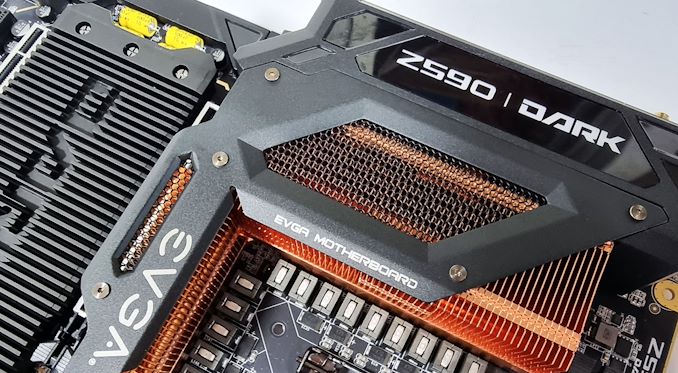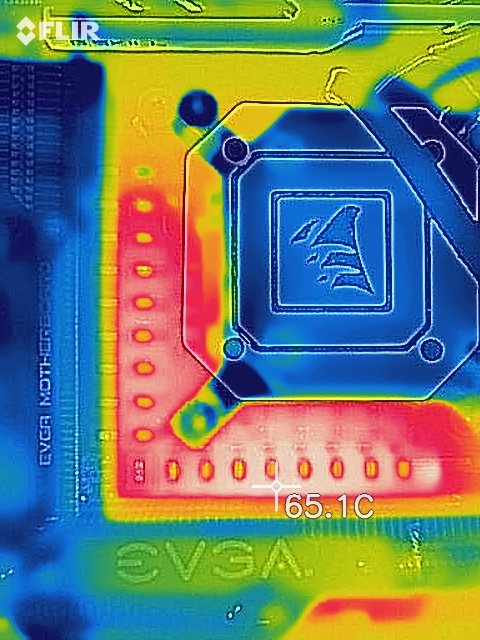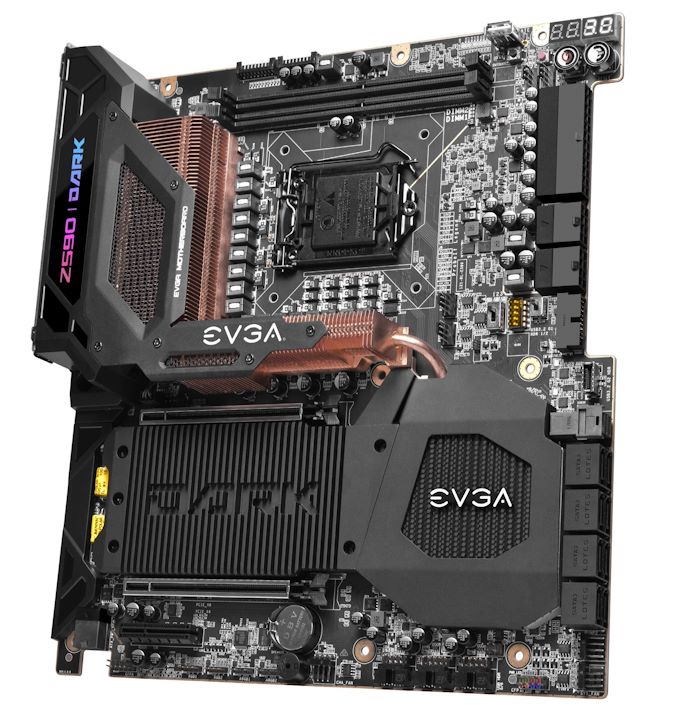The EVGA Z590 Dark Motherboard Review: For Extreme Enthusiasts
by Gavin Bonshor on October 15, 2021 9:00 AM EST
Getting the most out of Intel's Core i9-11900K primarily relies on two main factors: premium cooling for the chip itself, and a solid motherboard acting as the foundation. And while motherboard manufacturers such as EVGA can't do anything about the former, they have quite a bit of experience with the latter.
Today we're taking a look at EVGA's Z590 Dark motherboard, which is putting EVGA's experience to the test as one of a small handful of LGA1200 motherboards geared for extreme overclocking. A niche market within a niche market, few people really have the need (or the means) to overclock a processor within an inch of its life. But for those that do, EVGA has developed a well-earned reputation with its Dark series boards for pulling out all of the stops in helping overclockers get the most out of their chips. And even for the rest of us who will never see a Rocket Lake chip pass 6GHz, it's interesting to see just what it takes with regards to motherboard design and construction to get the job done.
EVGA Z590 Dark Overview
EVGA occupies an unusual spot within the wider motherboard market. The company has eschewed low-end and mid-range motherboards entirely, opting to focus on high-end boards. Case in point: of the handful motherboards they currently offer, the major of them are Dark boards aimed at extreme overclocking.
The end result is that while EVGA doesn't make (or sell) a lot of boards, what they do make stands out. And in the case of the Dark series (and thus the Z590 Dark) that starts with outright over-engineering motherboards in order to equip them with far more (or far higher grade) components than are actually needed. For a motherboard to operate within its parameters, such as Intel default settings on processors, they don't require things like ridiculously high phase counts to achieve this. But for extreme overclocking, it's another matter.
Some may say that overclocking isn't as popular as it once was, and to some degree that's true. Due to the advancements from both Intel and AMD on its methods and definitions of 'turbo' and 'boost,' it's not as fundamentally needed as it once was.
But don't tell the EVGA Z590 Dark that. Going so far as to support aggressive sub-ambient CPU cooling methods like liquid nitrogen (LN2) and dry ice (DICE), the EVGA Z590 Dark is a serious contender for those looking for maximum performance. An overclocker's toolkit is designed to make sub-zero overclocking more accessible, including dual Probelt voltage monitoring points and a dual two-digit LED debugger that can even read out current CPU VCore and temperatures.
It uses a transposed LGA1200 socket for better CPU pot mounting. Above the CPU socket is two horizontally mounted memory slots with support for DDR4-5333 out of the box and a maximum capacity of up to 64 GB, more than ample for anyone's desktop system. Other fanciful design traits include right-angled connectors, including the power connectors along the right-hand side, s |USB headers, and 4-pin fan headers.
With that said, not everything is aimed at overclocking, so the Z590 Dark includes a solid and fundamental feature set to boot. There's plenty of variety for storage with one PCIe 4.0 x4 M.2, one PCIe 3.0 x4 M.2, one PCIe 3.0 x4/SATA M.2, one rare PCIe 3.0 x4 U.2 slot, and eight SATA ports. Also present is a premium onboard audio solution and plenty of networking options with two 2.5 GbE controllers and an Intel Wi-Fi 6 CNVi. Other features include USB 3.2 G2x2 Type-C connectivity on the rear panel through native support on the Z590 chipset, while the Z590 Dark also has four USB 3.2 G2 Type-A ports.
Touching on the performance of the EVGA Z590 Dark in our testing, it showed that it's competitive with other Z590 boards we've tested. It's not as power-efficient as some other Z590 models, but we got good results in our POST time test, and it displayed incredible performance in our DPC latency testing. The performance in our compute and gaming benchmarks also shows the Dark is competitive with other models on test.

The EVGA Z590 Dark undergoing our VRM thermal testing
When it comes to overclocking, which the EVGA Z590 Dark is primarily designed for, we admittedly didn't see anything overly special compared to other Z590 boards – but then we "only" used a premium Corsair 360 mm AIO, rather than something more exotic. Still, the EVGA OC Robot utility built into the firmware was able to provide us with an impressive 5.4 GHz all-core stable overclock, but with a CPU VCore of 1.541 V and a whopping power draw of 497 W. Pragmatically, this overclock did run with a minus 3 offset on AVX workloads which meant it passed our POV-Ray benchmark. Still, we did see thermal throttling due to the insane amount of heat generated. Power delivery thermals were also respectable, but we would have liked to have seen better thermal performance than we got considering this board has an active cooling design.
Reflecting its high-end nature, the EVGA Z590 Dark carries a price tag of $599. And somewhat surprisingly, this isn't too outlandish for an enthusiast-grade overclocking motherboard in today's market, particularly when sizing up other high-end boards. Still, motherboards such as the MSI MEG Z590 Ace ($430) offer a much more comprehensive feature set with very competitive performance levels for users who aren't going to be applying dry ice to their CPUs. So where the Z590 Dark excels is going to be different from other high-end boards, and that's something that suits EVGA just fine.
Read on for our extended analysis.












27 Comments
View All Comments
YB1064 - Friday, October 15, 2021 - link
If this board is built for LN2 overclocking, then a review without testing this capability is incomplete. Come on guys, you used to do this in the past. What gives?Ryan Smith - Friday, October 15, 2021 - link
Speaking pragmatically, when we do that kind of testing, we're at serious risk of burning out a $500 CPU. For a comprehensive overclocking-focused article that may make sense, but for single motherboard review that's not a very good use of our resources.To be sure, it would be fun to do - and ideally I'd like to make it happen. But there are some niche features/configurations that even we can't justify the cost of testing.
niva - Friday, October 15, 2021 - link
Do people actually run their systems with LN2 cooling? Or is it something that just exists to be used temporarily when doing extreme benchmarks?I've been building PCs since the 90s and never even bothered with liquid coolers, never mind LN2. Seems like a complete gimmick and as you stated, risky. Not just for the CPU resources, but potentially dangerous to the people setting up the system.
shabby - Friday, October 15, 2021 - link
If it's targeted for ln2 that means they can charge a pretty penny for it, that's all it means.Ryan Smith - Friday, October 15, 2021 - link
You're correct: no one is using LN2 on a day-to-day basis. It's mostly for short use periods for extreme overclocking.amnesia0287 - Friday, October 15, 2021 - link
The stuff they change to make it work with LN2 still benefit everyone else, just less. Cause basically what they do is swap in higher quality chips that are better hardened. They tighten up the tolerances (which is why it’s only got 2 ram slots, to make the traces shorter and more consistent).Same with the upgrade to the power delivery and pci traces.
Can a human tell the difference from any of these things? No way, but they will certainly help a cpu last longer and run more stable. It just doesn’t make sense to spend on any current pc hardware with all the changes about to pop off. Just pci5 and the addition of cxl are gonna be huge.
Oxford Guy - Saturday, October 16, 2021 - link
‘Extreme overclocking’ = extreme marketing techniquefrozen_water - Friday, October 15, 2021 - link
Meh, having owned the z490 dark kp edition I think these boards are way overrated. Does this one still have a silkscreen URL for a non-existent TiN guide? Does this still not support Intel’s cryo/TEC coolers? It’s literally the most expensive oc motherboard out there and it lacks features that other much cheaper ones have.Silver5urfer - Friday, October 15, 2021 - link
Unfortunately TiN is retired from EVGA. He moved to US I guess due to family. Now those nice amazing articles on Xdevs are nowhere since Z490 series. The only person now covering this extensively is Luumi. Check his content, he also makes Win7 installs just like TiN as well.I'm eying this board with 10900K or X570 DARK if the AMD board also drops USB then I'm skipping Ryzen.
amnesia0287 - Friday, October 15, 2021 - link
OC motherboards mostly all a waste of money for most people. But just looking at the vrms, power delivery, tight uniform ram traces and such. They are extremely focused on pure electrical stability/consistency/reliability. Though certainly not to the same degree, it is built similarly to military hardened pc gear in some ways.